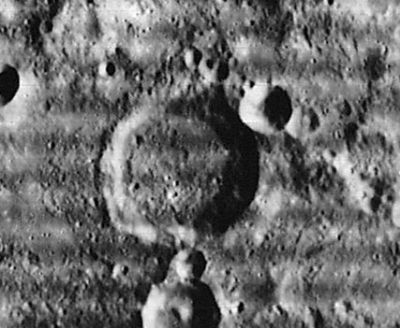Almanon
Contents
[hide]Almanon
|
Lat: 16.85°S, Long: 15.14°E, Diam: 47.76 km, Depth: 2.48 km, Rükl: 56 |
Images
LPOD Photo Gallery Lunar Orbiter Images Apollo Images
- Orbital Fairchild-Metric/Mapping photographs of Almanon, made during the mission of Apollo 16, are online in the oblique southward-looking frames of Magazine Rev 26) (Almanon's location is south-southeast of Abulfeda, the crater which is mentioned in the LPI's list).
- Research: Danny Caes
Maps
(LAC zone 96A2) LAC map Geologic map
Description
Elger
(IAU Directions) ALMANON.--This ring-plain, with its companion Abulfeda on the N.W., is a very interesting telescopic object. It is about 36 miles in diameter, and is surrounded by an irregular border of polygonal shape, the greatest altitude of which is about 6,000 feet above the floor on the E. It is slightly terraced, and is broken on the S. by a deep crater pertaining to the bright and large formation Tacitus b, the W. border of which casts a fine double-peaked shadow at sunrise. On the N.E. there is another bright crater, the largest of the row, running in a E.S.E. direction, and forming a E. extension of the remarkable crater-chain tangential to the borders of Almanon and Abulfeda. The only objects on the floor are three little hills, in a line, near the centre, a winding ridge on the E. side of it, and two or three other low elevations.
Wikipedia
Additional Information
- IAU page: Almanon
- Depth data from Kurt Fisher database
- Westfall, 2000: 2.48 km
- Viscardy, 1985: 2.48 km
- Cherrington, 1969: 2.01 km
- Satellite crater Almanon C is on the ALPO list of banded craters
Nomenclature
- According to the IAU Planetary Gazetteer this feature is named for Abdalla Al Mamun (786-833), identified (even though the Wikipedia link describes him as an Abbasid caliph with no obvious astronomical connections) as "a Persian astronomer."
- The reason the name entered the IAU Nomenclature in Named Lunar Formations (catalog #3751, attributed to Riccioli) as Almanon is that Mary Blagg, in her Collated List, found this feature labeled that way by all three of her authorities,
- Kuiper et al., in Table III of their Photographic Lunar Atlas, note that Almanon seems to be a misspelling by Beer and Mädler of the name Almaeon printed on Riccioli's map (under the second "T" in "Terra Sanitatis"), but recommend retaining the misspelling due to its long use. However, the name on Riccioli's map itself appears to a typographical error, which Beer and Mädler were perhaps trying to correct, for in Part 2 of his biographical Chronology Riccioli lists Almamon the caliph and Almaon son of the Persian astronomer Albumasar (787-886, see: digital copy of book by "Albumasar", noted on the bookplate as the most famous of Arabic astrologers), but no Almaeon. Both names listed in the Chronology differ by one letter from the spelling on the map. Almamon seems the more likely intent since in Part 1 of the Chronology Riccioli lists Almamon (next to the year 827) but neither Albumasar nor Almaon. Also, historian Lynn Thorndike is cited elsewhere as saying he thinks references to "Almeon" in medieval literature are to the caliph listed by the IAU, so Riccioli's mention of an otherwise unknown son of Albumasar named Almaon may be confused.
LPOD Articles
Bibliography
- Harold Hill. A Portfolio of Lunar Drawings, pages 178, 179 (last stages of illumination on Geber, Almanon, and Abulfeda).
Named Featues -- Prev: Al-Khwarizmi -- Next: Al-Marrakushi
